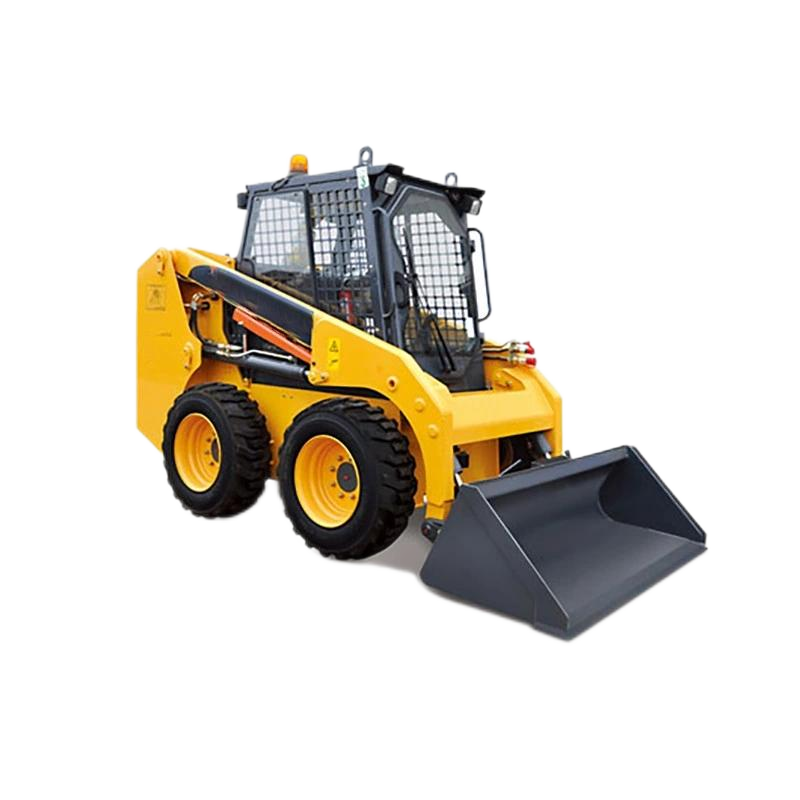Small loaders (with a power of less than 74kW) can be classified in various ways, usually based on structural forms, driving methods, application scenarios, and functional configurations. Different classifications correspond to different applicable scenarios and characteristics. The specific classifications are as follows:

I. Classification by Structural Form
This is the most common classification method, mainly based on differences in body structure and operational flexibility:
Wheeled Small Loaders
- Features: Adopt tire - based travel, with strong maneuverability and fast driving speed (generally 10 - 30km/h). They are suitable for working on hardened roads (such as rural roads, factory grounds) or non - muddy sites.
- Advantages: Small turning radius, can quickly transfer between sites without the need for additional transportation equipment, and is the mainstream type of small loaders currently.
- Applicable Scenarios: Most small and medium - sized scenarios such as building decoration, agricultural transportation, and municipal maintenance.
Tracked Small Loaders
- Features: Use tracked travel, with low ground pressure (low pressure on the ground) and strong grip. They are suitable for muddy, soft, or rugged sites (such as farmland, mountains, swamps).
- Disadvantages: Slow driving speed (usually less than 10km/h), need to rely on trailers for site transfer, and maintenance costs are slightly higher than those of wheeled ones.
- Applicable Scenarios: Agricultural deep tillage, wetland operations, small mines, or construction in complex terrain.
II. Classification by Driving Method
The main difference lies in the power transmission mode, which affects work efficiency and energy consumption:
Mechanically Driven Small Loaders
- Features: Transmit power through mechanical structures such as clutches and gearboxes. They have a simple structure, are easy to maintain, and have low costs, but the operation is relatively labor - intensive (requiring manual gear shifting).
- Applicable Scenarios: Scenarios with low requirements for operational accuracy (such as bulk material handling, simple site leveling), suitable for individual farmers or small construction teams.
Hydraulically Driven Small Loaders
- Features: Use a hydraulic system to control the travel and working devices, with smoother operation (stepless speed change), flexible speed adjustment, and can achieve precise operations (such as indoor material stacking).
- Advantages: Low labor intensity, adapt to complex work needs, but maintenance costs are slightly higher.
- Applicable Scenarios: Scenarios with high requirements for operational flexibility (such as warehouse loading and unloading, operations in narrow spaces).
Electric Small Loaders
- Features: Powered by batteries, with zero emissions and low noise. They are suitable for indoor use or scenarios with high environmental protection requirements (such as operations near workshops and residential areas).
- Limitations: Battery life is affected by battery capacity (generally continuous operation for 4 - 8 hours), and supporting charging facilities are required.
- Applicable Scenarios: Indoor warehouses, municipal greening, farms, and other areas sensitive to environmental protection and noise.
III. Classification by Application and Functional Configuration
According to the degree of specialization of work requirements, they can be divided into general - purpose and special - purpose types:
General - purpose Small Loaders
- Features: Equipped with a standard bucket, mainly used for basic operations such as material handling and site leveling. Functions can be expanded by replacing attachments (such as log grapples, snow plows).
- Applicable Scenarios: Users who need to handle multiple scenarios (such as individual operators using them for both agriculture and small - scale construction).
Special - purpose Small Loaders
Designed for specific scenarios, equipped with special attachments or structures:
- Agricultural Special - purpose: Equipped with silage forks and feed buckets, suitable for feed transportation and straw processing in farms;
- Municipal Special - purpose: Equipped with snow plows and sweeping brushes, used for road snow removal and site cleaning;
- Warehousing Special - purpose: With a shorter body (to adapt to warehouse height) and a side - shiftable bucket, suitable for stacking in narrow passages;
- Mining Auxiliary Type: With a reinforced body structure and wear - resistant buckets, used for short - distance ore transportation in small mines.
IV. Classification by Rated Load Capacity
The load capacity of small loaders is usually matched with their power and self - weight, and can be divided into:
- Lightweight Small Loaders: Rated load capacity of 0.5 - 1.5 tons, self - weight of 1.6 - 3 tons. Suitable for light materials (such as fertilizers, feed, small building materials), mostly used in agriculture or indoor operations;
- Medium - sized Small Loaders: Rated load capacity of 1.5 - 3 tons, self - weight of 3 - 6.5 tons. Can transport heavier materials such as sand and gravel, bricks, and are suitable for both construction and municipal scenarios.
Summary
The essence of classifying small loaders is to adapt to the needs of different scenarios: wheeled ones focus on flexible site transfer, while tracked ones focus on complex terrain; mechanical transmission focuses on low cost, while hydraulic/electric transmission focuses on operational experience; general - purpose ones are suitable for multiple scenarios, while special - purpose ones are suitable for single high - intensity operations. Users can choose the corresponding type according to the work site, material type, and functional needs to maximize equipment utilization.





